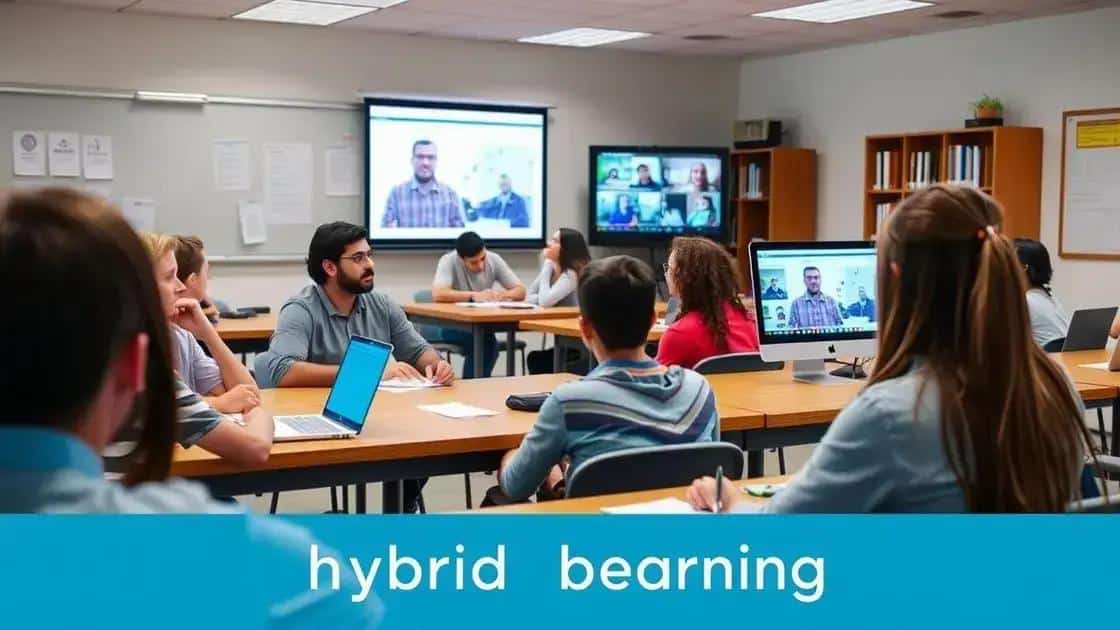Hybrid learning success trends you need to know

Hybrid learning combines in-person and online instruction, providing flexibility and personalized experiences while enhancing student engagement through advanced technology and a focus on social-emotional skills.
Hybrid learning success trends are transforming how we perceive education today. Have you ever wondered how these trends affect learning and teaching? Let’s dive into their impact.
Understanding hybrid learning
Understanding hybrid learning is essential in today’s educational environment. This approach combines traditional face-to-face teaching with online instruction. Students can benefit from the flexibility of online learning while still having in-person interaction.
What is Hybrid Learning?
Hybrid learning blends both in-person and digital experiences. By offering this format, schools cater to a variety of learning styles. This method can enhance engagement and increase student satisfaction.
Benefits of Hybrid Learning
- Flexibility in scheduling and learning pace
- Enhanced access to resources and materials
- Personalized learning experiences
- Improved student-teacher interactions
Moreover, incorporating technology into education enhances student access to diverse materials. For instance, online forums allow students to communicate easily with classmates, making discussions richer and more insightful. This interactive aspect can greatly enhance the educational experience.
It’s also important to recognize the challenges that hybrid learning presents. Teachers must adapt new skills, and students need to develop self-discipline to thrive. However, embracing these changes can lead to significant improvements across educational institutions.
Key Components of Successful Hybrid Learning
Successful hybrid learning involves several critical components that support both teachers and students:
- Robust technology infrastructure
- Clear communication strategies
- Regular feedback and assessment
- Engaging content delivery
By focusing on these elements, schools can create a cohesive and effective hybrid learning environment. This not only benefits students but also prepares them for future learning demands.
Key factors for success

Understanding the key factors for success in hybrid learning is essential for both educators and students. A well-implemented hybrid learning model can lead to significant improvements in student engagement and performance.
Effective Communication
Clear communication is vital in a hybrid learning environment. Teachers should maintain open lines of communication with students and parents. This ensures everyone understands expectations and resources available.
Technology Integration
Utilizing appropriate technology is another factor. Schools need to invest in tools that facilitate online learning. With the right resources, students can easily access materials and participate in discussions.
- Learning management systems (LMS)
- Interactive educational platforms
- Video conferencing tools
- Digital assessment tools
Moreover, training teachers to effectively use these technologies can make a huge difference. Professional development sessions can help educators become more comfortable with digital resources and improve their teaching methods.
Student engagement is also crucial. In hybrid learning, it’s essential to keep students motivated. Teachers can employ various strategies to encourage active participation. Incorporating group activities and interactive lessons keeps the class dynamic and engaging.
- Group projects
- Class discussions
- Peer feedback
- Gamification elements
Lastly, measuring success through feedback is key. Regular assessments and surveys help identify what works and what needs adjustment. This allows educators to adapt and enhance their approaches.
Challenges in hybrid learning
The challenges in hybrid learning can significantly impact both educators and students. Recognizing these obstacles is vital for creating effective learning environments.
Technological Issues
One major challenge is related to technology. Not all students have equal access to reliable devices or internet connections. This digital divide can hinder engagement and learning outcomes.
Engagement and Motivation
Keeping students engaged in a hybrid setting can also be difficult. When learning online, some students may feel isolated or disconnected from their peers. They may struggle to stay motivated and focused.
- Inconsistent participation in online classes
- Lack of interaction with peers
- Difficulty in maintaining attention
Additionally, teachers face challenges in monitoring student progress. It can be hard to assess understanding when students are participating remotely. This uncertainty can be stressful for educators.
Teaching Strategies
Finding the right teaching strategies for a hybrid model is essential. Teachers must adapt their methods to engage students effectively. This includes using various teaching tools and techniques that work well both online and in person.
- Interactive lessons to increase participation
- Utilizing multimedia resources
- Providing clear instructions and expectations
The transition between in-person and online formats can also cause confusion. Students may struggle to switch gears, impacting their overall learning experience. Therefore, it’s crucial for teachers to provide consistent communication and support through these transitions.
Future of hybrid learning

Exploring the future of hybrid learning reveals exciting possibilities for educators and students alike. As technology advances, the ways we teach and learn are continuously evolving.
Increased Flexibility
One significant aspect is the flexibility that hybrid learning offers. Students can tailor their learning experiences to fit their schedules and personal needs. This model promotes a sense of autonomy and responsibility, leading to better student engagement.
Integration of Advanced Technology
The future will likely see the integration of more advanced technologies. Tools such as virtual reality (VR) and augmented reality (AR) can create immersive learning experiences. These technologies make lessons more interactive and help students grasp complex concepts more easily.
- Enhanced visualization of subjects
- Real-life simulations for practical learning
- Collaboration tools that facilitate teamwork
Furthermore, using artificial intelligence (AI) can personalize learning. AI can analyze students’ progress and tailor content to address their strengths and weaknesses. This individualized approach can enhance learning outcomes significantly.
Focus on Social-Emotional Learning
Additionally, the future of hybrid learning will emphasize social-emotional skills. Educators will focus on developing not only academic skills but also emotional intelligence. This approach enables students to build resilience, empathy, and effective communication.
- Incorporating mindfulness practices
- Encouraging peer collaboration
- Providing support for emotional well-being
As institutions adapt their curricula, they will likely focus on creating inclusive environments. This will ensure that all students, regardless of background or learning style, can thrive. Hybrid learning offers the potential to bridge gaps and create more equitable educational opportunities for everyone.
Conclusion: The evolution of hybrid learning shows promise for the future of education. By integrating technology, fostering engagement, and focusing on social-emotional skills, we can create inclusive learning environments. As schools adapt to these changes, they will encourage more effective learning experiences, preparing students for future success.
FAQ – Frequently Asked Questions about Hybrid Learning
What is hybrid learning?
Hybrid learning combines online and face-to-face instruction, allowing students to benefit from both methods.
What are the benefits of hybrid learning?
Hybrid learning offers flexibility, personalized learning experiences, and increased access to resources.
What challenges do teachers face in hybrid learning?
Teachers may struggle with technology access, student engagement, and adapting teaching methods for different environments.
How can schools ensure effective hybrid learning?
By using robust technology, engaging content, clear communication, and focusing on social-emotional learning.





